#lady mary cambridge
Explore tagged Tumblr posts
Text
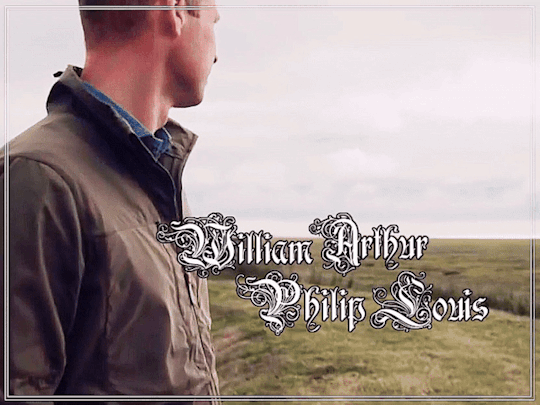
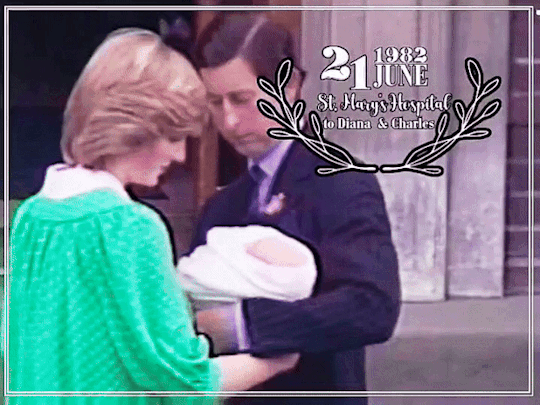





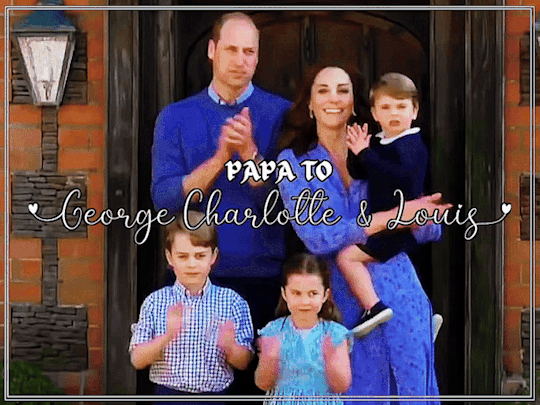

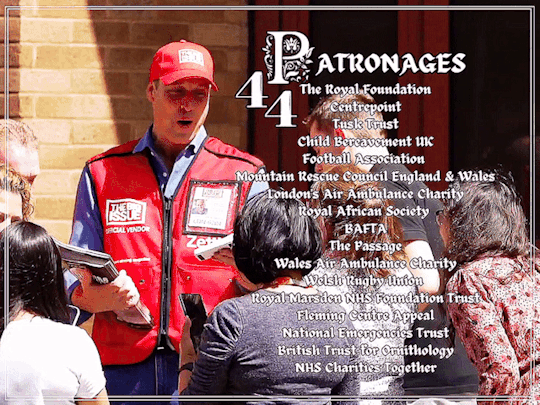
HAPPY 42ND BIRTHDAY TO HRH THE PRINCE OF WALES, WILLIAM ARTHUR PHILIP LOUIS ♡
On 21 June 1982, Prince William was born to Diana and Charles, then known as Prince and Princess of Wales in St Mary's Hospital, London, at at 21:03 BST. He was born during the reign of his paternal grandmother Elizabeth II and was the first child born to a Prince and Princess of Wales since Prince John's birth in July 1905.
The little prince's name was announced on 28 June as William Arthur Philip Louis. Wills was christened in the Music Room of Buckingham Palace by the then Archbishop of Canterbury, Robert Runcie, on 4 August.
William studied at Jane Mynors' nursery school and Wetherby School in London before joining Ludgrove. He was subsequently admitted to Eton College, studying geography, biology, and history at the A-level.
The Prince undertook a gap year taking part in British Army training exercises in Belize, working on English dairy farms, and as part of the Raleigh International programme in southern Chile, William worked for ten weeks on local construction projects and taught English.
In 2001, William enrolled at the University of St Andrews, initially to study Art History but then changed his field of study to Geography with the support of the love of his life Catherine Elizabeth Middleton who he met while at school.
Will and Cat fell in love during their time at uni, and married at Westminster Abbey on 29 April 2011. The couple have three adorable cupcakes Prince George (b.2013), Princess Charlotte (b.2015) and Prince Louis (b.2018). The family of five divide time between their official residence, Kensington Palace and their two private residences - Amner Hall & Adelaide Cottage.
After university, William trained at the Royal Military Academy Sandhurst. In 2008, he graduated from the Royal Air Force College Cranwell and joined the RAF Search and Rescue Force in early 2009. He transferred to RAF Valley, Anglesey, to receive training on the Sea King search and rescue helicopter, which made him the first member of the British royal family since Henry VII to live in Wales.
During his active career as a Search and Rescue Pilot, William conducted 156 search and rescue operations, which resulted in 149 people being rescued. He then served as a full-time pilot with the East Anglian Air Ambulance starting in July 2015, donating his full salary to the EAAA charity.
Working with all branches of the military, he holds the ranks of Lieutenant Colonel in the Army, Commander in the Navy and Wing Commander in the Air-Force
Upon their wedding, WillCat became HRH The Duke and Duchess of Cambridge, The Earl and Countess of Strathearn and Baron and Lady Carrickfergus. He became the heir apparent on 8 September 2022, receiving the titles of the Duke of Cornwall & The Duke of Rothesay. William & Catherine were made The Prince and Princess of Wales by Kimg Charles on 9 September 2022. Additionally, William also became the Prince & High Steward of Scotland, Earl of Chester, Earl of Carrick, Lord of the Isles, and Baron Renfrew.
As well as undertaking royal duties in support of The King, both in the UK and overseas, The Prince devotes his time supporting a number of charitable causes and organisations with some of his key areas of interest being Mental health, Conservation, Homelessness, Sports and Emergency Workers.
He has undertaken several overseas trips representing the monarch, covering a wide array of countries like Australia, Canada, Namibia, Malaysia, South Africa, Tanzania, Pakistan Italy, Jordan, Kuwait, France, India, The Bahamas, Belize, Afghanistan etc ; He is also is also a founder of various initiatives like United For Wildlife, Heads Together, Earthshot and Homewards.
#happy birthday william ❤️#william's 42nd birthday#prince of wales#the prince of wales#prince william#william wales.#william prince of wales#british royal family#british royals#royals#royalty#brf#royal#british royalty#catherine middleton#kate middleton#duchess of cambridge#2024 wales birthdays#prince george#princess charlotte#prince louis#royaltyedit#royalty gifs#royalty edit#royaltygifs#my gifs#21062024
170 notes
·
View notes
Text
A Wedding to Remember Ch. 6 Home Truths Realized

We are back with the longest chapter in the fic, as well as where we earn our rating! If smut isn't your thing, stop reading at the double scene change line and resume reading at the same. I hope you enjoy the chapter and let me know what you think! Thank you again to @snowbellewells for the lovely artwork up above!!!
Summary: Killian Jones, younger brother to the viscount, is home from Cambridge and ready to enter society, including finding himself a wife. Perhaps he may find his future bride here, at a week long house party his sister-in-law is hosting at the Jones country estate before the London season officially begins.
Rating: M (smut)
Words: 3100 of approximately 16k
Tags: Bridgerton Inspired Fic, Matchmaking, Regency Romance
On ao3 From Beginning / Current Chapter
Tagging the usuals. Please let me know if you'd like to be added or removed.
@jrob64 @winterbaby89 @hollyethecurious @the-darkdragonfly @jennjenn615
@donteattheappleshook @undercaffinatednightmare @pirateherokillian @cocohook38 @qualitycoffeethings
@booksteaandtoomuchtv @superchocovian @motherkatereloyshipper @snowbellewells @djlbg
@lfh1226-linda @xarandomdreamx @tiganasummertree @bluewildcatfanatic @anmylica
@laianely @resident-of-storybrooke @exhaustedpirate @gingerchangeling @caught-in-the-filter
@ultraluckycatnd @stahlop @darkshadow7 @fleurdepetite @captainswan-kellie
@soniccat @beckettj @teamhook @whimsicallyenchantedrose @jonesfandomfanatic
@elfiola @zaharadessert @ilovemesomekillianjones @mie779 @kymbersmith-90
@suwya @veryverynotgoodwrites @myfearless-love
Under the cut, unless Tumblr ate it.
Ch. 6 Home Truths Realized
Killian sat in the dark of the upstairs parlor, a half empty bottle of his brother’s second best rum on the desk in front of him.
When Mary Margaret’s father arrived from their estate after being summoned by Liam, Killian had retired, having no connection to the newly affianced couple, nor any purpose in what were sure to be extensive negotiations and details to be hammered out by Liam, David, and Lord Blanchard.
So he sat here, in the dark, most of the way to being very drunk, trying to make sense of the maelstrom of conflicting feelings inside him. He was quite relieved that the betrothal of Miss Blanchard took away the choice he was facing between herself and Miss Nolan. Though he was also thoroughly dismayed at the physical altercation between himself and David when the earl and Miss Blanchard were discovered. He’d felt a nearly familial connection with the man when they’d initially met and feared that friendship might now be ruined. And then there were the feelings he was harboring for Miss Nolan herself. Now that he could see clearly - without the associated confusion and guilt that he’d felt when he first realized his affections for her - the difference between what David and Miss Blanchard shared and what he initially felt for Miss Blanchard were glaringly obvious. Especially in the light of the love he now recognized he held for Miss Nolan.
How could he have been so blind? He believed himself to be an intelligent gentleman, even-tempered overall - though more than willing and able to defend and protect if called upon to do so - and not prone to following the whims of emotion that so often characterized young men and ladies alike. So how he could have fancied himself in love with Miss Blanchard, even for a moment, was quite beyond him.
Yes, she was beautiful, beyond any doubt, but so was Miss Nolan. Breathtakingly, in fact. And where Miss Blanchard was gracious, kind, and accommodating to a fault - the timeless elegance of a pearl - Miss Nolan possessed an inner fire, a strength of character and will that was due to adversity and external pressure - the hard edges and flash of a diamond. And while he recognized the rare beauty and value of a pearl, his own personal taste leaned toward the alluring sparkle of the most valuable gem on earth.
After spending the week with both ladies, he knew exactly where his heart truly belonged. Firmly in the hands of Miss Emma Nolan.
The masquerade was still going on downstairs, and he could only assume that Miss Nolan had been returned to the ballroom once the principal parties sequestered themselves in Liam’s study. Perhaps he should return as well. If she was still there, he might have occasion to speak with her, or even share a dance.
But first, he must determine if he was too drunk to make an appearance.
Could he stand? Yes.
Could he walk? Yes!
Ah, but could he walk a straight line? Eh, not quite.
He huffed in frustration and opened the door to the darkened hallway. A figure caught his eye as he left the study. He blinked to bring the figure into focus, then a happy smile spread across his lips as he realized it was none other than Miss Nolan - walking along the center of the hallway runner, head down, murmuring something under her breath.
“I beg your pardon,” he said, making her gasp in surprise and no small amount of fright.
“Mr. Jones,” she cried, her hand flying to her chest. “I… I didn’t see you there.”
“Yes… well… I…” he stammered, gesturing behind him towards the parlor he’d just left, but unable to think of anything else to say. He scratched behind his ear in embarrassment before finally lifting his eyes to hers. “I was going to return to the masquerade, but as I was only doing so in order to see if you were still in attendance, I was quite pleased to find you here just as I was leaving.”
Her mouth worked, but nothing was coming out. Maybe he’d frightened her more than he thought.
“Miss Nolan?” he asked, hesitantly, reaching out but stopping before actually touching her.
She shook her head briefly and looked down, refusing to look him in the face. “With all my companions absent, I saw no need to remain in the company of the matron Lady Jones placed me with before resuming her duties as hostess. She couldn’t be expected to remain with me the remainder of the evening, not if she wanted to keep tonight’s… eh… events from her other guests.”
Emma could feel the heat on her cheeks and could only hope the hallway was too dark for him to notice. Just the thought of what they’d nearly walked in on and what was now going on downstairs was enough to send her heart into palpitations.
Which were not helped in the least by Mr. Jones’ sudden appearance in the darkened hallway. He literally took her breath away. His hair was a little more disheveled than normal, and his mask and cravat were missing entirely. Even in the dim light she could see the high color of his cheeks, and his eyes, though slightly unfocused, still sparkled.
She really should continue on her way.
But she couldn’t bring herself to move. Nor could she think of a single thing to say.
Mr. Jones swayed slightly, and Emma reached out in case he lost his balance completely.
“Mr. Jones,” she inquired softly, “are you… intoxicated?”
He appeared to think about it for a moment - his brow furrowed and stroking the scruff along his jaw. “Yes, I believe I am,” he finally said. “Though I’m not quite sure exactly how drunk I am.”
Emma couldn’t have hidden her surprise if she’d tried. “Is that something you usually know? Exactly how drunk you are, I mean.” She was clearly at her articulate best this evening.
“Yes, actually,” he replied. “I can usually tell exactly how drunk I am. But for some reason, not tonight. I rather suspect…” He trailed away and Emma waited for him to continue. When several seconds of quiet had passed, she huffed in frustration. Why did people always stop speaking just when they were about to say something meaningful?
“Mr. Jones?” she prodded. “You suspect what?”
He shook his head rather briskly for someone who was clearly intoxicated. She was amazed that he remained steady on his feet afterward.
“Not important,” he asserted. “Not in the slightest.”
Silence descended again, and Emma was quite at a loss of what to say or do to remove herself from this situation. She really shouldn’t be standing here in a darkened hallway… alone… with him…
So naturally, she didn’t move.
He was looking at her in the most peculiar way. Almost as if he was seeing her for the first time. His head tilted a bit in question, his eyes searching hers as he reached for and lifted her chin just the right amount for his lips to gently touch hers.
If she wasn’t so stunned at his drunken audacity, she might have had the wherewithal to push him away. Might have, anyway. She’d like to think so. After all, this was a man who’d been completely besotted with her dearest friend, and she could only assume the reason for his drunkenness was the devastation of his broken heart at what had transpired earlier. He would never have done this had he been sober.
But that knowledge made no difference to her traitorous heart. It pounded in her chest so that she was sure he could feel it as his arms encircled her and pulled her close. His lips against hers were gentle, coaxing, light as air, but insistent at the same time. She was utterly powerless against the surge of emotion his tender affection raised in her.
She was a maiden. A debutante. She’d never been touched by a man - other than her brother - much less kissed. Though her betrothal was now official, her heart belonged to the man who now held her in his arms, and while she should push him away, she couldn’t bring herself to do so, propriety be damned.
She was leaving for London in the morning - as were they all - but she’d be preparing for her wedding instead of making her debut into society. The way he held her, the way he touched her, was igniting something inside her that she was helpless against. Whatever his reasons were for kissing her now, as well as secretly getting drunk far away from the rest of the houseguests, she didn’t know. But she couldn’t resist him.
She loved him.
And this was her one chance to experience love.
Of their own volition, her arms lifted and wound around him, one hand settling in his hair, the other stroking the skin of his neck where it met his shoulder. His lips left hers and peppered the softest of kisses down to her jaw and then down the slope of her neck. Her head fell back, granting him more access, as a trembling sigh left her lips.
“Emma,” he whispered into her skin. His lips left an unquenchable fire in their wake that Emma feared would burn her to cinders. Every part of her was lined up to every part of him and she could feel an urgent hardness at her hip.
She gasped into his mouth as his lips captured hers once more. A low moan escaped her as his tongue sought out hers, tenderly caressing, leading her along a sensory overload that threatened to drown her.
“Killian,” she breathed. He lifted his head from hers, the smile on his lips positively blinding. It happened so suddenly that if he hadn’t been holding her so closely, she would have collapsed into a puddle at his feet. “What?” she asked in a daze.
“You called me by my name,” he informed her.
Emma’s mouth dropped open, then closed, then opened again. “W - well,” she stammered, “you… called me… by mine…” She could barely string the words together, so caught up as she was in the passion between them.
“Emma, I…” He stopped when she shook her head sharply. She didn’t want to hear anything he had to say, for it couldn’t possibly be anything beneficial to her and to the state of her heart.
“Don’t, please,” she begged. “I can’t bear it.” She looked up into his eyes and saw more than she ever thought she’d see directed toward her. Affection, tenderness, wonder, and passion all swirled in the bottomless pools of his azure gaze. Was it possible that what she was seeing was actually meant for her and not another? Was there any way under heaven that Killian Jones cared for her? She shoved the thought away before it could even truly form. Of course, he didn’t. But that wouldn’t stop her from inviting him to her room and to her bed tonight. She wanted just one chance to know the love and happiness that David and Mary Margaret had found before she submitted herself to the sentence imposed on her a decade ago.
She drew in a deep breath, never breaking their gaze, before finding her voice again. “Will you…”
“Will I…?” he repeated, softly.
She stared up at him, like a tremulous rosebud, just on the cusp of opening to the summer sun. He’d never seen anything more beautiful in all his born days. If eyes were truly the windows of the soul, then he knew his heart had truly found its home. The passion and love filling his own heart were reflected in her gaze and the joy that surged within him knew no bounds.
“Will you… come…?” she asked, quietly, hardly above a whisper.
“Will I come, with you? To your room?” he replied. She nodded slowly, red flushing her entire countenance. “I would be honored.” He cupped her face in his hands and gently kissed her before tucking her arm into his and escorting her down the hall.
It wasn’t lost on him that she was inviting him into her room. The room she shared with Miss Blanchard. By accepting her invitation, he wanted to show her that he accepted what she wanted to give him. That he accepted her - and all that she was - without reservation or condition. If he’d suggested his own room, he feared that she’d perceive the overture as nothing more than trying to interpose his own desires - his own wants and needs - over her own. When instead, all he wanted to communicate to her was that he loved her. In the most passionate and ancient way possible.
“Miss Blanchard will be occupied for some hours yet, I’m sure,” he whispered as they approached her door. It was too holy a moment for him to speak any louder. She nodded as he opened the door for her and she preceded him inside. Once the door was shut behind them, Killian caught her hand and turned her toward him.
Moonlight streamed into the room from the tall window on the other side, bathing her face in its silver beams. Her skin looked like the finest porcelain and the jade of her eyes nearly glowed in the soft light. Within their depths he saw her love and desire, laid bare for him alone to see. The tremendous gift she was giving to him took his breath away.
~*~*~
~*~*~
He drew her back into his arms and let his lips and hands speak for him as he slowly undressed her, worshipping her as each part of her body was uncovered to his gaze. The gasps and moans of pleasure that fell from her lips were music to his ears. Once he laid her out on the bed, he rose and began to undress as he simply admired the glorious beauty before him.
“Don’t, please,” he urged when she went to cover herself. He laid down by her side, gently taking one hand in his own and gathering her to him with the other. “You take my breath away, Emma.”
Emma caught her breath at his quiet words. Looking up into his eyes, she completely forgot whatever she’d been about to say in reply. The heat from his skin enveloped her, like a well-tended fire. She reached out for him, her touch tentative until he nodded encouragingly.
“Yes, Emma,” he said. “You can touch me. I want you to touch me.”
The gentle reassurance in his words gave her enough confidence to continue. Killian kissed the pad of each finger he held in his hand as her other hand traced the firm muscles of his chest and arms. The strength she found there thrilled her completely. He rolled them until she was firmly beneath him, surrounded by him, her senses completely overwhelmed by him.
“Killian, please,” she whispered just before he captured her lips again. His hands roamed her naked skin, and his hips rocked into hers, that hard part of him rubbing against her deliciously, pushing her higher and higher until with a gasping cry, cascades of sublime ecstasy filled her very being.
She floated on a cloud of transcendent completion for some moments before she could open her eyes. When she finally did, the look on his face took what little breath she had left completely away. Joy and utter delight filled his countenance. She was helpless to do anything but return his beautiful smile.
“This will hurt at first,” he informed her, gently, “but it will only be this one time, and it will last but a few moments.”
She’d heard the same from some of her classmates, so she simply nodded in reply. He leaned down and began kissing her neck, his tongue tracing circles into her skin and sending delightful shivers down her spine as he made them one. The accompanying sting wasn’t nearly as bad as she’d expected, and when he began to move within her, she met him eagerly, his name a gasp on her lips.
The tension was growing inside her once more as they moved together, and as his hips met hers again and again, she chased her release, their cries and moans of ecstasy mingling until she reached that pinnacle once again and felt him throb within her, signaling his own completion.
~*~*~
~*~*~
He collapsed on top of her, and she held him as tightly as she possibly could, loving the feeling of him against her and not wanting him to leave her embrace too quickly. A satisfied hum left her lips as she pressed them against the skin of his neck. It was answered by a quiet moan as he rolled away from her embrace.
He looked down at her and took one of her hands in his own, placing it over his heart. “I don’t want to crush you.”
“You weren’t,” she promised, in a whisper. “I rather liked the feel of you.” She could feel the blush staining her cheeks and looked away from the tenderness of his gaze. She didn’t want the illusion to shatter just yet. It would come soon enough. “Thank you,” she murmured.
“Thank you? For what?”
“For joining me… here,” she stammered. “For giving me a taste.”
His brows furrowed together before he spoke. “Of course, Emma. I wouldn’t have refused your request.”
“I know,” she replied hurriedly. “But you didn’t have to. I just wanted…” She shook her head, trying to find the words to explain. His fingers trailed down the side of her face and the gentleness of the action nearly brought tears to her eyes. “I have something to tell you.”
“What?”
“I’m to be…”
The knob on the door rattled, interrupting her. They both turned their heads sharply, their mouths agape.
“Mary Margaret!” she exclaimed. “Quick! Get under the bed.”
Killian rolled to the floor and under the bed as the door opened. He reached out and grabbed his clothing, hoping against hope that the darkness meant that Miss Blanchard wouldn’t notice the scattered clothes on the floor of the room.
He was as silent as he could be as he listened to her enter the room and prepare for bed. He drew shallow breaths as she climbed into the bed and whispered Emma’s name. When long moments of silence were her only answer, he didn’t know if Emma was only feigning sleep to keep their liaison a secret or if she’d truly drifted off. Either way, he was stuck where he was until he was sure Miss Blanchard slept.
Thankfully, it wasn’t long before he could hear the soft whistling snores of both of the ladies' breaths, signalling true sleep. He crawled out from under the bed, quickly dressed, and slipped silently from the room.
~*~*~
Thank you for reading and sharing! Next chapter will be up on Friday!
21 notes
·
View notes
Text

Christening of PRINCE RICHARD OF GLOUCESTER, October 20, 1944 // RCT
‘The Duchess of Gloucester had another son a few days ago [August 26] - a Caesarian operation - and there is much discussion as to what name the child shall be given. The King favours Charles, which I think would be a good idea, but the Gloucesters apparently fancy Richard.’
Alan ‘Tommy’ Lascelles - diary entry, 31 August 1944
photograph shows L to R. (standing): the Earl of Dalkeith, the Duke of Buccleuch, the King, the Duke of Gloucester, George II of the Hellenes, the Marquess of Cambridge. (seated): Lady Margaret Alexander (who stood proxy for General Sir Harold Alexander), Princess Margaret, Lady Sybil Phipps, the Queen, the Duchess of Gloucester with baby Richard, Queen Mary, Princess Marie Louise, Princess Elizabeth. (seated in front): Prince Michael and Princess Alexandra of Kent and Prince William of Gloucester.
#King George VI#Queen Mother#Prince Richard Duke of Gloucester#Queen Elizabeth II#Princess Margaret#Princess Alice#Prince Henry#Queen Mary#British Royal Family#1944#1940s#Princess Alexandra of Kent#Prince Michael of Kent#Prince William of Gloucester#George II of Greece#Princess Marie Louise#i've never used this many tags before lol
42 notes
·
View notes
Text
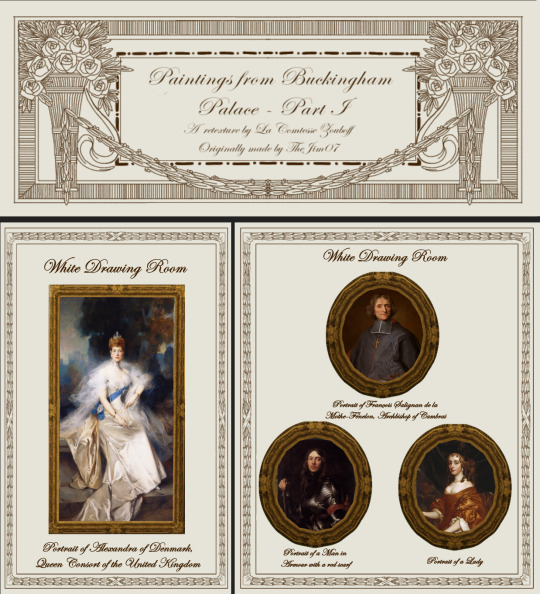
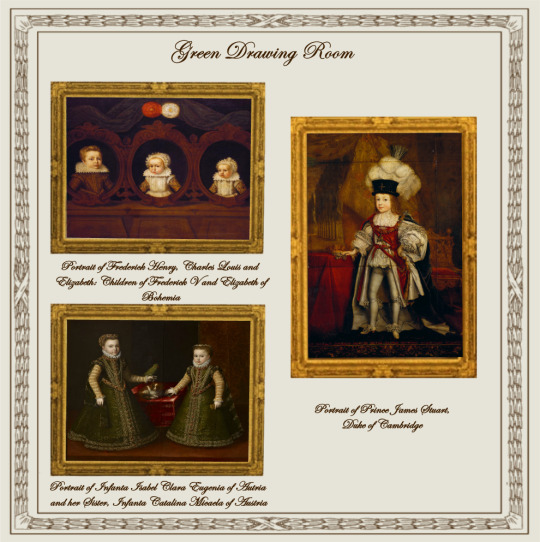
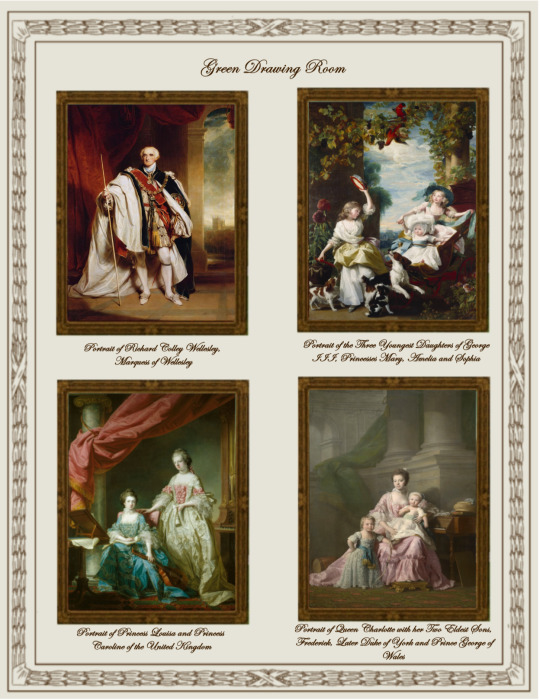
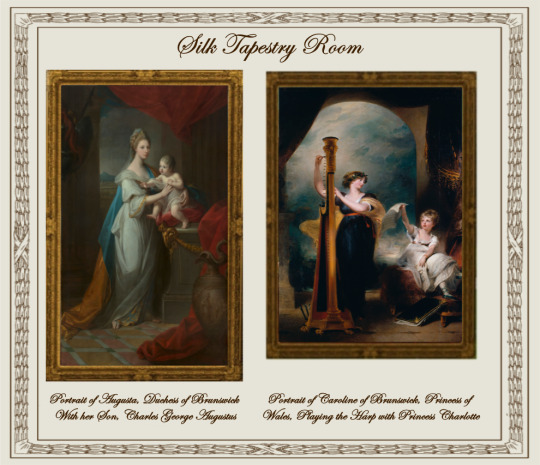
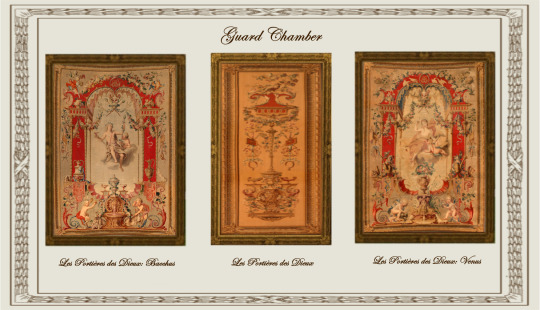
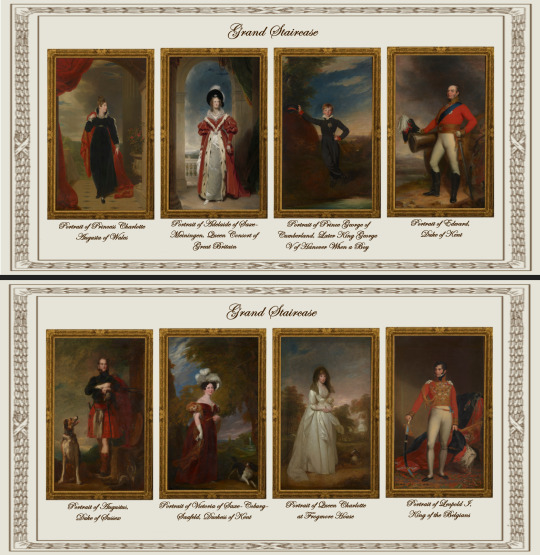
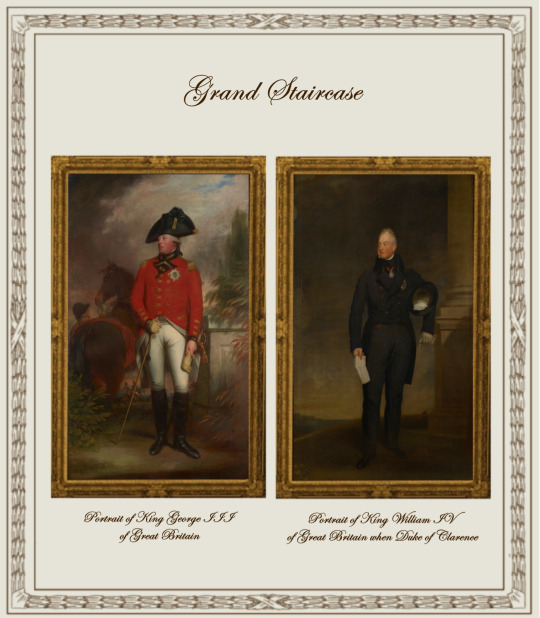
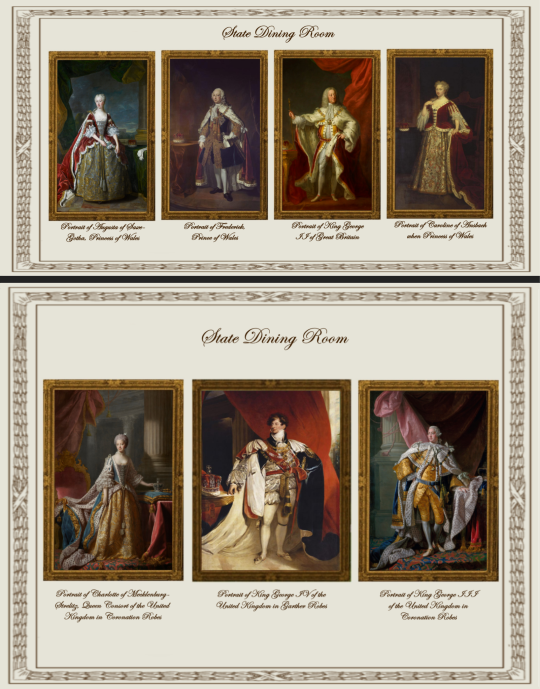
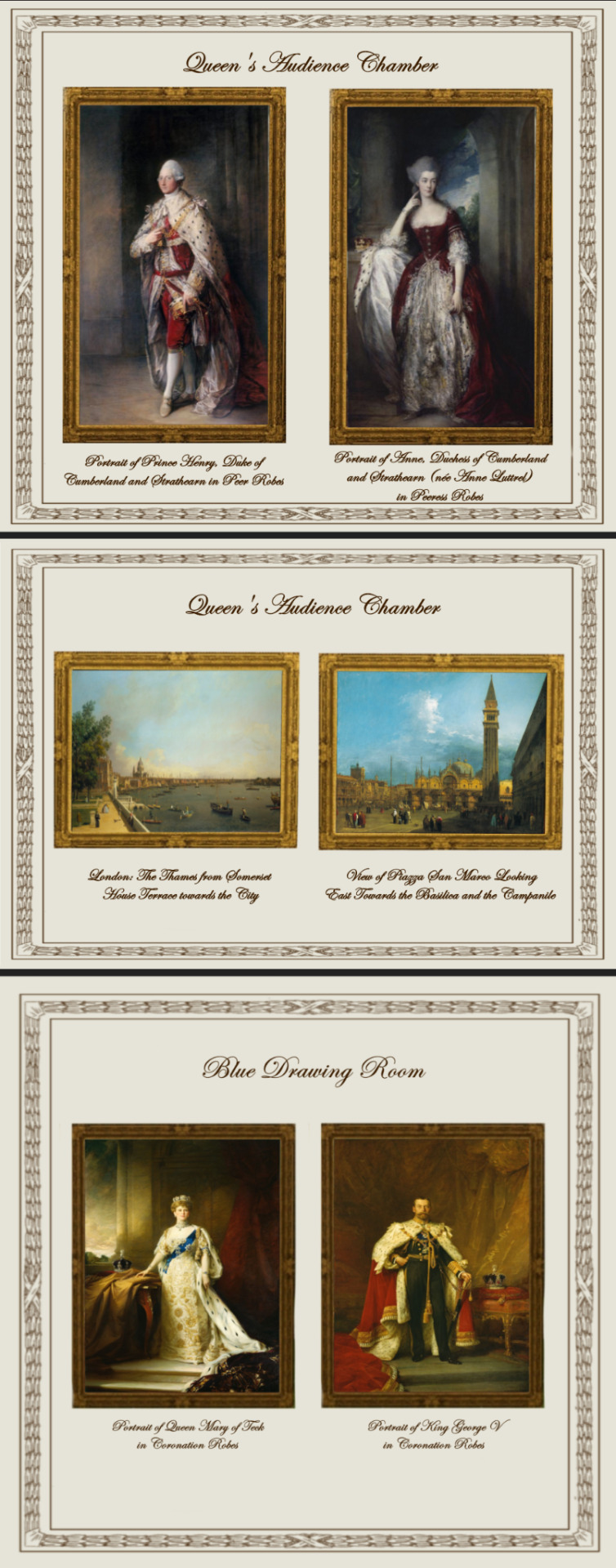
Paintings from Buckingham Palace: part I
A retexture by La Comtesse Zouboff — Original Mesh by @thejim07
100 followers gift!
First of all, I would like to thank you all for this amazing year! It's been a pleasure meeting you all and I'm beyond thankful for your support.
Spread among 13 occupied and historic royal residences in the United Kingdom, the collection is owned by King Charles III and overseen by the Royal Collection Trust. The British monarch owns some of the collection in right of the Crown and some as a private individual. It is made up of over one million objects, including 7,000 paintings, over 150,000 works on paper, this including 30,000 watercolours and drawings, and about 450,000 photographs, as well as around 700,000 works of art, including tapestries, furniture, ceramics, textiles, carriages, weapons, armour, jewellery, clocks, musical instruments, tableware, plants, manuscripts, books, and sculptures.
Some of the buildings which house the collection, such as Hampton Court Palace, are open to the public and not lived in by the Royal Family, whilst others, such as Windsor Castle, Kensington Palace and the most remarkable of them, Buckingham Palace are both residences and open to the public.
About 3,000 objects are on loan to museums throughout the world, and many others are lent on a temporary basis to exhibitions.
-------------------------------------------------------
This first part includes the paintings displayed in the White Drawing Room, the Green Drawing Room, the Silk Tapestry Room, the Guard Chamber, the Grand Staircase, the State Dining Room, the Queen's Audience Room and the Blue Drawing Room,
This set contains 37 paintings and tapestries with the original frame swatches, fully recolourable. They are:
White Drawing Room (WDR):
Portrait of François Salignan de la Mothe-Fénelon, Archbishop of Cambrai (Joseph Vivien)
Portrait of a Lady (Sir Peter Lely)
Portrait of a Man in Armour with a red scarf (Anthony van Dyck)
Portrait of Alexandra of Denmark, Queen Consort of the United Kingdom and Empress of India (François Flameng)
Green Drawing Room (GDR):
Portrait of Prince James Stuart, Duke of Cambridge (John Michael Wright)
Portrait of Frederick Henry, Charles Louis and Elizabeth: Children of Frederick V and Elizabeth of Bohemia (unknown)
Portrait of Infanta Isabel Clara Eugenia of Autria and her Sister, Infanta Catalina Micaela of Austria (Alonso Sanchez Coello)
Portrait of Princess Louisa and Princess Caroline of the United Kingdom (Francis Cotes)
Portrait of Queen Charlotte with her Two Eldest Sons, Frederick, Later Duke of York and Prince George of Wales (Allan Ramsay)
Portrait of Richard Colley Wellesley, Marquess of Wellesley (Martin Archer Shee)
Portrait of the Three Youngest Daughters of George III, Princesses Mary, Amelia and Sophia (John Singleton Copley)
Silk Tapestry Room (STR):
Portrait of Caroline of Brunswick, Princess of Wales, Playing the Harp with Princess Charlotte (Sir Thomas Lawrence)
Portrait of Augusta, Duchess of Brunswick With her Son, Charles George Augustus (Angelica Kauffmann)
Guard Chamber (GC):
Les Portières des Dieux: Bacchus (Manufacture Royale des Gobelins)
Les Portières des Dieux: Venus (Manufacture Royale des Gobelins)
Les Portières des Dieux (Manufacture Royale des Gobelins)
Grand Staircarse (GS):
Portrait of Adelaide of Saxe-Meiningen, Queen Consort of Great Britain (Martin Archer Shee)
Portrait of Augustus, Duke of Sussex (Sir David Wilkie)
Portrait of Edward, Duke of Kent (George Dawe)
Portrait of King George III of Great Britain (Sir William Beechey)
Portrait of King William IV of Great Britain when Duke of Clarence (Sir Thomas Lawrence)
Portrait of Leopold I, King of the Belgians (William Corden the Younger)
Portrait of Prince George of Cumberland, Later King George V of Hanover When a Boy (Sir Thomas Lawrence)
Portrait of Princess Charlotte Augusta of Wales (George Dawe)
Portrait of Queen Charlotte at Frogmore House (Sir William Beechey)
Portrait of Victoria of Saxe-Coburg-Saafeld, Duchess of Kent (Sir George Hayter)
State Dining Room (SDR):
Portrait of Charlotte of Mecklenburg-Strelitz, Queen Consort of the United Kingdom in Coronation Robes (Allan Ramsay)
Portrait of King George III of the United Kingdom in Coronation Robes (Allan Ramsay)
Portrait of Augusta of Saxe-Gotha, Princess of Wales (Jean-Baptiste Van Loo)
Portrait of Caroline of Ansbach when Princess of Wales (Sir Godfrey Kneller)
Portrait of Frederick, Princes of Wales (Jean-Baptiste Van Loo)
Portrait of King George II of Great Britain (John Shackleton)
Portrait of King George IV of the United Kingdom in Garther Robes (Sir Thomas Lawrence)
Queen's Audience Room (QAR):
Portrait of Anne, Duchess of Cumberland and Strathearn (née Anne Luttrel) in Peeress Robes (Sir Thomas Gainsborough)
Portrait of Prince Henry, Duke of Cumberland and Strathearn in Peer Robes (Sir Thomas Gainsborough)
London: The Thames from Somerset House Terrace towards the City (Giovanni Antonio Canal "Canaletto")
View of Piazza San Marco Looking East Towards the Basilica and the Campanile (Giovanni Antonio Canal "Canaletto")
Blue Drawing Room (BDR)
Portrait of King George V in Coronation Robes (Sir Samuel Luke Fildes)
Portrait of Queen Mary of Teck in Coronation Robes (Sir William Samuel Henry Llewellyn)
-------------------------------------------------------
Found under decor > paintings for:
500§ (WDR: 1,2 & 3)
1850§ (GDR: 1)
1960§ (GDR: 2 & 3 |QAR 3 & 4)
3040§ (STR, 1 |GC: 1 & 2|SDR: 1 & 2)
3050§ (GC:1 |GS: all 10|WDR: 4 |SDR: 3,4,5 & 6)
3560§ (QAR: 1 & 2|STR: 2)
3900§ (SDR: 7| BDR: 1 & 2|GDR: 4,5,6 & 7)
Retextured from:
"Saint Mary Magdalene" (WDR: 1,2 & 3) found here .
"The virgin of the Rosary" (GDR: 1) found here .
"The Four Cardinal Virtues" (GDR: 2&3|QAR 3 & 4) found here.
"Mariana of Austria in Prayer" (STR, 1, GC: 1 & 2|SDR: 1 & 2) found here.
"Portrait of Philip IV with a lion at his feet" (GC:1 |GS: all 10|WDR: 4 |SDR: 3,4,5 & 6) found here
"Length Portrait of Mrs.D" (QAR: 1 & 2|STR: 2) found here
"Portrait of Maria Theresa of Austria and her Son, le Grand Dauphin" (SDR: 7| BDR: 1 & 2|GDR: 4,5,6 & 7) found here
(you can just search for "Buckingham Palace" using the catalog search mod to find the entire set much easier!)
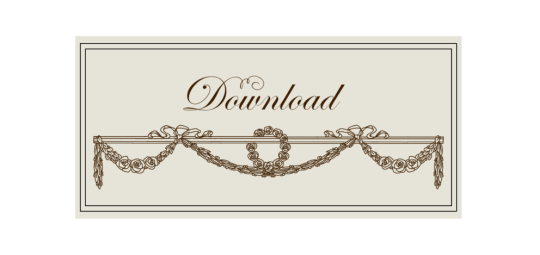
Drive
(Sims3pack | Package)
(Useful tags below)
@joojconverts @ts3history @ts3historicalccfinds @deniisu-sims @katsujiiccfinds @gifappels-stuff
-------------------------------------------------------
#the sims 3#ts3#s3cc#sims 3#sims 3 cc#sims 3 download#sims 3 decor#edwardian#rococo#baroque#renaissance#buckingham#buckingham palace#royal collection trust#wall decor
133 notes
·
View notes
Text
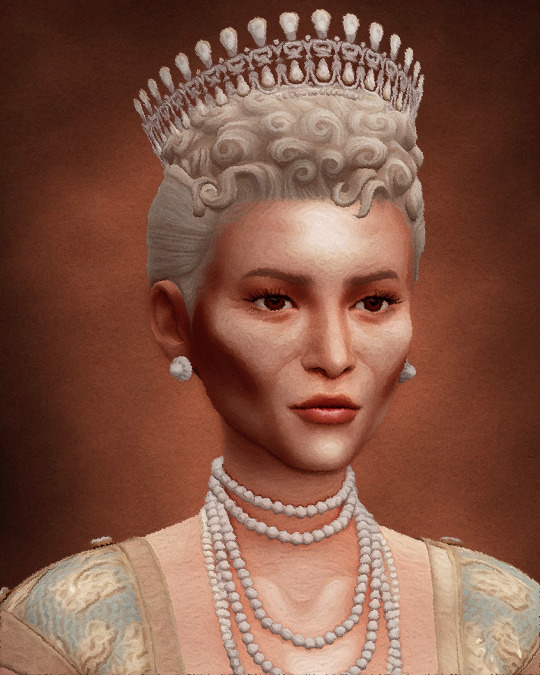
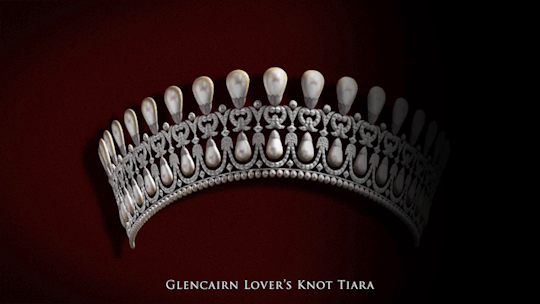
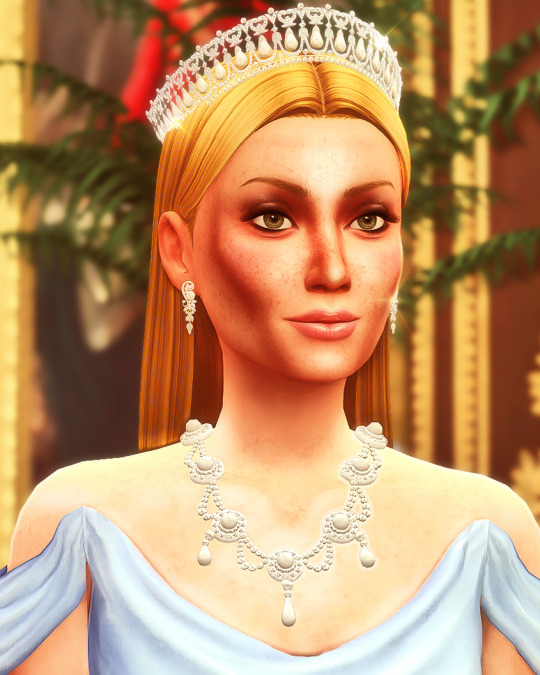

Sunderland’s Royal Jewel Vault (5/∞) ♛
↬ Glencairn Lover's Knot Tiara
In terms of jewelry, Sunderland has a very rich history that dates back centuries. The Glencairn lover's knot tiara is one of the oldest in the royal vault and has been passed down, from parent to child, since the days of King George. It is uncertain when this tiara was made. Featuring thirty-eight pear-shaped pearl pendants and lover's knot motifs, the design has proven popular. The Sunderland lover's knot is joined by the Cambridge and Bavarian lover's knot tiaras. All three tiaras were created in the 1800s, and all three are often mistaken for the much younger British version that was commissioned a century later. Despite their similarities, each of these tiaras have a distinct history and providence. In 1837, the Sunderland variant was gifted to Lady Imogen Longford as she prepared to marry the Duke of Glencairn, the second brother of King Louis III. The tiara was among other priceless gifts, for Imogen wasn't just marrying some prince, but a likely future king. The Duke's two older brothers had no surviving legitimate issue, and Sunderland was in the midst of a fierce succession crisis that pitted brother against brother. Ultimately, Imogen never became queen, that prize belonged to her German sister-in-law, Princess Caroline of Mecklenburg-Stralsund. However, Imogen was the mother of a king, giving birth to the future King George in 1839. As a result, most of her jewels are still worn by members of the royal family to this day. Sunderland's lover's knot tiara is perhaps the most famous of Imogen's jewels, having been worn by princesses and queens from every generation succeeding her. Despite rumours that the tiara is noisy, producing an awful "clacking" sound with every step its wearer takes, it has been a favourite of Queen Matilda Mary, Queen Anne, and Queen Irene in unflinching succession. The tiara is easy to fiddle with, flexible, with the top rows of pearls being removable. Since the 1830s it has starred in countless portraits, official images, and state events. Today, the tiara is on a long-term loan to Tatiana, Princess of Danforth who debuted the tiara in 2001. Since then the tiara has become her one of her most worn, next to her family's own diamond tiara. With the lover's knot's enduring popularity, it will be interesting to see who will don the sparkler next—at this point, it's almost a rite of passage.
A 1927 portrait of Queen Matilda Mary. She wears the tiara with its 18 pearl toppers.
Tatiana, Princess of Danforth wears the tiara sans toppers at a reception in June, 2018.
#warwick.jewels#✨#gif warning#ts4#ts4 story#ts4 royal#ts4 storytelling#ts4 edit#ts4 royal legacy#ts4 legacy#ts4 royalty#ts4 monarchy#ts4 screenshots#warwick.extras
36 notes
·
View notes
Text

I'm a paper conservator (though I don't post about that often here, so don't follow me expecting this kind of content) and I'll be assisting with a chemistry course on blue pigments and dyes next semester. I'm also trying to help get the chemistry folks the funding to get an infrared camera to examine artwork in my art museum for potential pigment analysis.
If you like looking at illuminated manuscripts, the Fitzwilliam Museum at Cambridge has a gorgeous website called Illuminated: Manuscripts in the Making. It's full of high res images, often with infrared layers that you can examine too, and occasional microscopic images, and TONS of information about each manuscript including history, artistic style, artist's materials, etc. This website is the modern version of an old book of hours, beautiful and the highest quality and no expense spared.


This page (folio 20r) from The Hours of Isabella Stuart is fun for infrared examination. Most of the gorgeous blue was painted in ultramarine, which was one of the most expensive pigments, up there with gold, and it's the reason the Virgin Mary and Jesus are often portrayed wearing blue. But the owner, the duke of Brittany, changed the lady patron at the lower left (who may have been his first wife) and got an artist to paint his new fiancee Isabella Stuart instead, with her patron Saint Catherine behind her, clothed in ultramarine blue. Later he had it repainted again to change her headdress to a duchess's crown, but this time the artist used azurite blue which is slightly cheaper. It almost looks the same in normal light, but under infrared the azurite shows up as dark while ultramarine looks much lighter.
17 notes
·
View notes
Text






















taylor swift lyrics x colors x textiles in art – red
Fifteen – Fearless // Augusta of Bavaria with Her Children – Andrea Appiani ❤️ Love Story – Fearless // Portrait of a Prussian Prince – Unknown Artist ❤️ Red – Red // Apples – Kuzma Petrov-Vodkin ❤️ All Too Well – Red // Birdsong – Károly Ferenczy ❤️ All Too Well – Red // Portrait of a Lady – John Opie ❤️ The Moment I Knew – Red // Portrait of Sophia Hedwig of Brunswick-Lüneburg – attributed to Wybrand de Geest ❤️ Nothing New – Red // Sibylla Palmifera – Dante Gabriel Rossetti ❤️ Blank Space – 1989 // Tomaž Hren – unknown artist ❤️ Style – 1989 // Ernest Amadej Tomaž Attems – unknown artist ❤️ Wildest Dreams – 1989 // A Vision of Fiametta – Dante Gabriel Rossetti ❤️ New Romantics – 1989 // Portrait of Armand Gaston Maximilien de Rohan – Hyacinthe Rigaud ❤️ End Game – Reputation // A Genoese Lady with Her Child – Anthony van Dyck ❤️ I Did Something Bad – Reputation // Marie-Adélaïde de France – Johann Julius Heinsius ❤️ Look What You Made Me Do – Reputation // Infanta Isabel of Spain – Carlos Luis de Ribera y Fieve ❤️ Daylight – Lover // Self-Portrait – Gwen John ❤️ the lakes – folklore // Maria Amalia of Saxony – Anton Raphael Mengs ❤️ gold rush – evermore // Barine – Edward Poynter ❤️ Maroon – Midnights // Margaret “Peg” Woffington – unknown artist ❤️ Maroon – Midnights // Portrait of Marchessa Marianna Florenzi – Joseph Karl Stieler ❤️ Maroon – Midnights // Henry IV, King of France in Armor – Frans Pourbus the Younger ❤️ Maroon – Midnights // Elizabeth I as a Princess – attributed to William Scrots ❤️ The Great War – Midnights // Augusta, Duchess of Cambridge with Her Children – Melchior Gommar Tieleman
#fearless#fearless taylor swift#red#red taylor swift#red taylor’s version#1989#1989 taylor swift#reputation#reputation taylor swift#lover album#lover taylor swift#folklore#folklore album#folklore taylor swift#folklore ts#evermore taylor swift#evermore ts#evermore#evermore album#midnights#midnights album#taylor swift midnights#midnights taylor swift#taylor swift#long post#taylor swift lyrics x colors x textiles in art
143 notes
·
View notes
Text
Watching Ghosts (S1,E2) Gorilla war (spoilers)
• Mike is such an amazing husband
• The pigeon and robin scared the absolute hell out of me and Alison
• Alison just ran into a door
• It’s Ben Willbond !!!!!!!! (I love him)
• The intro is and will always be amazing
• Mike using the drill like it’s a gun and singing 😂
• Poor Fanny just wants sleep.
• The drilling over Fanny’s speech is really funny
• Kitty is too cute and pure for this world
• She’s The only one who can see them
• “You beastly wretch”
• “And a first from Cambridge”
• Robin reenacting his incident with the bear
• Captain directing everything like always
• Thomas really just loves Alison
• “I had cousin, that’s all he said”
• Mr sledgehammer”
• “Why is it always about war with you”
(Captain noises)
• “ I stopped a crisis, By starting a war”
• “HOW DARE YOU”
• “Imagine that slammed”
• Julian is trying to google himself like we all have done before
• Mike is singing again
• Fanny hates the portrait of her ex husband. For obvious reasons
• Kitty being goofy with the hole in the wall
• “I thought we were friends”
• Julian was so close
• There’s not internet in the basement
• “Or just hit it with a hammer”
• The captain’s fascination with the tv
• “Looks like some idiot took a hammer to it”
The idiot was you, Mike
• Alison is trying to ignore the Captain Backfired
• Julian is trying to google himself again
• “Hello to you”
• Pat is such a nice guy by giving Alison a tour of the house
• “Chambre - That’s French”
• “You beautiful girl” Talking about the war documentary
• Julian’s plan also backfired horribly
• “If you were dead,I would thrash your bottom, sir” I’m sorry what ????
• Mary is just trying her best even if she’s is just repeating “ Get out,Get out, Get out”
• Robin in the pantry
• Julian interrupting Alison on the phone
• Fanny trying to teach Alison to be a ✨ Proper lady ✨
• “ A lady wouldn’t tell me to do that to myself”
• Mary is trying again which is preventing Alison from sleeping
• “I am the very model of a modern major general” Needs to be my alarm
• No Robin in the pantry but in the fridge
• Julian ranting about “The chancellor’s red box” and “the man in the sailor’s sauna”
• Can Thomas leave Alison alone ???????
• The weirdest love confession
• Can they all stop yelling at Alison
• Why is Kitty under the covers ?????
• “Do you think it’s something we said.” She ran away screaming, Pat
• Mike is trying to fix the boiler
• She has become aware of the plague people in her basement
• The room is full of “donkeys”
• She needs medical attention
• The doctor was a ghost
• She can see all the ghosts everywhere
• She stood up to the ghosts !!!!
• The house is in harmony
• Mike knows the ghosts are there
• They fixed the boiler
I rate it a 10/10 because it was such a good follow up episode and I’m really excited to watch the rest

#ghosts bbc#ben willbond#matthew baynton#jim howick#lolly adefope#simon farnaby#charlotte ritchie#martha howe douglas#laurence rickard#kiell smith bynoe#tv series
12 notes
·
View notes
Text
Dramatis Personae (spoilers-light and corrections-light) of Nowe Thus, "" descriptions from Hunting the Falcon
Anne Boleyn, daughter of Sir Thomas Boleyn and Elizabeth Howard; wife of Henry VIII
First Introduction: Chapter 1
Henry VIII, King of England
First Introduction: Chapter 1
Sir Francis Weston, gentleman of the privy chamber
First Introduction: Chapter 1
Elizabeth Howard, daughter of Thomas Howard, Earl of Surrey and 2nd Duke of Norfolk; wife of Sir Thomas Boleyn, mother of Anne Boleyn, Dowager Countess of Wiltshire
First introduction: Chapter 2
Henry Norris, gentleman of the privy chamber, groom of the stool from 1526
First introduction: Chapter 2
Katherine of Aragon, youngest daughter of Queen Isabella I of Castile and King Ferdinand II of Aragon; married (1) Arthur, Prince of Wales; (2) Henry VIII as his first wife sister-in-law
First introduction: Chapter 2
George Boleyn, brother of Anne Boleyn; later Viscount Rochford, Warden of the Cinque Ports, Earl of Wiltshire
First introduction: Chapter 2
Mary Howard, Anne’s cousin, daughter of the 3rd Duke of Norfolk; wife of Henry Fitzroy; lady in-waiting; contributor to the Devonshire Manuscript
First introduction: Chapter 3
Jane Seymour, gentlewoman, third wife of Henry VIII
First Introduction: Chapter 4
Edward Seymour, elder brother to Jane
First Introduction: Chapter 4
Thomas Seymour, elder brother to Jane
First Introduction: Chapter 4
Margaret Douglas, Henry VIII’s niece; only child of Margaret Tudor and Archibald Douglas, and a leading contributor to the Devonshire Manuscript
First Introduction: Chapter 4
Jane Parker, wife of George Boleyn, daughter of Henry Parker, Lord Morley; one of Anne Boleyn’s ladies-in-waiting, Countess of Wiltshire
First Introduction: Chapter 5
Thomas Cranmer, Cambridge scholar and early protégé of the Boleyns; Archbishop of Canterbury from 1532
First Introduction: Chapter 6
Margaret Butler, wife of Sir William Boleyn and grandmother of Anne Boleyn; daughter and co-heir of Thomas Butler, Earl of Ormond
First Introduction: Chapter 6
Hugh Latimer, one of Anne’s chaplains; later Bishop of Worcester
First Introduction: Chapter 6
Sir William Paulet, courtier and privy councillor, Master of the Wards, comptroller of the royal household from 1532
First Introduction: Chapter 7
Princess Mary, daughter of Henry VIII and Katherine of Aragon
First Introduction: Chapter 7
Lady Anne Shelton (née Boleyn), Anne Boleyn’s aunt, mother of Mary and Margaret Shelton, custodian of Princess Mary
First Introduction: Chapter 7
Sir Thomas Boleyn, son of Sir William Boleyn and Margaret Butler; father of Anne Boleyn; later Viscount Rochford, Earl of Wiltshire, Lord Privy Seal
First Introduction: Chapter 8
Thomas Cromwell, self-trained lawyer and servant of Wolsey; parliamentary manager, Master of the Jewels and principal secretary to Henry VIII; later Vicar-general and Lord Privy Seal
First Introduction: Chapter 12
William Cavendish, gentleman-usher to Wolsey
First Introduction: Chapter 12
Lorenzo Campeggi, Cardinal and papal legate
First Introduction: Chapter 12
John Husee, court agent to Viscount and Lady Lisle
First Introduction: Chapter 12
Margaret Lee, Thomas Wyatt’s sister and mother of Elizabeth I’s Queen’s Champion, Sir Henry Lee
First Introduction: Chapter 12
Henry Fitzroy, Duke of Richmond, Duke of Somerset, Earl of Nottingham; illegitimate son of Henry VIII by Elizabeth Blount; married Mary Howard
First Introduction: Chapter 12
Sir Nicholas Carew, gentleman of the privy chamber, diplomat, supporter of Princess Mary; brother-in-law to Sir Francis Bryan
First Introduction: Chapter 12
Anne Stanhope, wife of Edward Seymour
First Introduction: Chapter 12
Dr William Butts, royal physician
First Introduction: Chapter 15
Margaret Gamage, gentlewoman; later married Lord William Howard as his second wife
First Introduction: Chapter 18
Mary/Margaret Shelton, Anne’s cousin, gentlewoman, contributor to the Devonshire Manuscript
First Introduction: Chapter 18
Lord Thomas Howard, lover of Margaret Douglas; a leading contributor to the Devonshire Manuscript; younger brother of Lord William Howard; stepbrother of Thomas Howard, 3rd Duke of Norfolk
First Introduction: Chapter 18
Elizabeth "Bess" Harvey, gentlewoman, Henry VIII's mistress
First Introduction: Chapter 19
Mary Boleyn, sister of Anne Boleyn; married (1) William Carey; (2) William Stafford
First Introduction: Chapter 19
Thomas Grey, Yeoman of the Bottles
First Introduction: Chapter 21
Charles Brandon, Duke of Suffolk; married (1) Anne Browne, daughter of Sir Anthony Browne; (2) Henry VIII’s younger sister Mary, widow of Louis XII; (3) Lady Katherine Willoughby
First Introduction: Chapter 22
Philippe Chabot, Seigneur de Brion, Admiral of France
First Introduction: Chapter 24
Catherine Carey, daughter of Mary Boleyn
First Introduction: Chapter 24
Philip Calthorpe, vice-chamberlain to the Princess Mary, husband of Jane Calthorpe, sister of Thomas Boleyn
First Introduction: Chapter 27
Elizabeth de Vere, Dowager Countess of Oxford
First Introduction: Chapter 27
Sir Francis Bryan, cousin of Anne Boleyn, gentleman of the privy chamber and diplomat; later known as the ‘Vicar of Hell'
First Introduction: Chapter 27
Henry (or Harry) Algernon Percy, eldest son of 5th Duke of Northumberland; 6th Earl of Northumberland from 1527
First Introduction: Chapter 28
Gertrude Blount, second wife of Henry Courtenay; close friend and lady-in waiting to Katherine of Aragon
First Introduction: Chapter 28
Elizabeth Carew, gentlewoman, sister of Francis Bryan, wife of Nicholas Carew, supporter of Princess Mary
First Introduction: Chapter 28
Thomas Howard, Earl of Surrey, 3rd Duke of Norfolk, Anne Boleyn’s uncle, brother of her mother Elizabeth Howard
First Introduction: Chapter 28
Margaret Pole, Countess of Salisbury, former governess to Princess Mary
First Introduction: Chapter 30
Edward Neville, cousin to Henry VIII, supporter of the Princess Mary
First Introduction: Chapter 32
#in order of...importance? /s#no but actually#especailly with paulet#literally more like#in order of what household official/ privy councilor would henry have likeliest given *this* specific task too#(or in his case...who amongst would be likelier to volunteer?#probably someone that had already had experience in 'handling' mary#and didn't want it to go to somebody worse (norfolk)#a 'middling' sort of politician#low risk and low reward#but collects up those low reward like a magpie#however; you ask me which scene i would use for a character trailer/introduction...#and that's a different question#like we see a much more subdued margaret douglas as a result of what has happened#but for an intro i would want her at her utmost spirited:#the social butterfly aspect...which would be more like chapter 18#all made different also because first introduction in the *story* is not necessarily first on the *chronological* timeline...#THAT would be a whole different order.#oh that would take me forever...it#would lowkey be fun tho...i love organizing.#realizing it's *unadulterated loathing*with every george/norris excerpt...#maybe i should do smth with that.#bi george? i like to keep it vague in RPH#'IS he...?'
5 notes
·
View notes
Text
A Wedding to Remember Ch. 2 Like Lightning from Heaven
We are back! Sorry it's so late in the day, but adulting had to come first unfortunately and I've only just finished. Tonights ch is VERY short, less than 1300 words, so I'll post Wednesday's ch tomorrow night before I go to bed. Thank you all for reading! I hope you enjoy and let me know what you think!!
Summary: Killian Jones, younger brother to the viscount, is home from Cambridge and ready to enter society, including finding himself a wife. Perhaps he may find his future bride here, at a weeklong house party his sister-in-law is hosting at the Jones country estate before the London season officially begins.
Rating: M (smut)
Words: Almost 1300 of approximately 16k
Tags: Bridgerton Inspired Fic, Matchmaking, Regency Romance
On ao3 From Beginning / Current Chapter
Tagging the usuals. Please let me know if you'd like to be added or removed.
@jrob64 @winterbaby89 @hollyethecurious @the-darkdragonfly @jennjenn615
@donteattheappleshook @undercaffinatednightmare @pirateherokillian @cocohook38 @qualitycoffeethings
@booksteaandtoomuchtv @superchocovian @motherkatereloyshipper @snowbellewells @djlbg
@lfh1226-linda @xarandomdreamx @tiganasummertree @bluewildcatfanatic @anmylica
@laianely @resident-of-storybrooke @exhaustedpirate @gingerchangeling @caught-in-the-filter
@ultraluckycatnd @stahlop @darkshadow7 @fleurdepetite @captainswan-kellie
@soniccat @beckettj @teamhook @whimsicallyenchantedrose @jonesfandomfanatic
@elfiola @zaharadessert @ilovemesomekillianjones @mie779 @kymbersmith-90
@suwya @veryverynotgoodwrites @myfearless-love
Under the cut, unless Tumblr ate it.
Ch. 2 Like Lightning From Heaven
Lady Emma Nolan had to fight to keep from rolling her eyes as she could all but see hearts suddenly appear in the gaze of Mr. Killian Jones, brother-in-law to their hostess, Viscountess Elsa Jones, when he kissed Mary Margaret’s hand.
It was no more or less than she was used to, but it had been lovely to simply converse with another lady without having to endure the fawning attentions of the masculine sect upon her constant companion and dearest friend.
Emma and Mary Margaret had been the closest of friends since they’d met at Miss Moss’s School for Exceptional Young Ladies three years prior. And it wasn’t until she’d accompanied Mary Margaret to her home in Kent for a summer visit when it became abundantly clear to her that Mary Margaret was a MOST Exceptional Young Lady indeed.
With her petite frame, black as midnight hair, green eyes, pale skin, round face, pert nose, and rosebud lips, she was an exceptional specimen of feminine beauty. Emma already knew that, of course, and while Mary Margaret herself never once made her feel less feminine or less attractive than herself, the young men who surrounded them whenever they ventured out accomplished that task most assuredly and decisively.
If Mary Margaret had not also been the sweetest, kindest, and most tender-hearted person on the planet, she would have been absolutely insufferable.
But as it was, Mary Margaret was the most amiable, good-natured, and pleasing person to be around. She never sought attention for herself and was always seeking ways to bring Emma into the spotlight of male attention wherever they went. And as they never went anywhere without the other, Emma had become quite accustomed to the besotted countenances that followed Mary Margaret constantly.
Emma knew that she wasn’t objectively unattractive on her own, but when compared to Mary Margaret, she never had and never would garner a second look.
And Mr. Killian Jones wasn’t any different.
Oh, he was very handsome, to be sure, well spoken, and charming as well, as evidenced by the conversation now flowing around her that he had no trouble joining. Suddenly the viscount appeared and stole their hostess away for a dance, leaving Emma and Mary Margaret in the company of the devastatingly handsome Mr. Killian Jones. That was enough to finally draw Emma out of her musings and focus her attention on the latest of a long line of suitors that fancied themselves in love with her closest friend.
They watched the couples on the dance floor twirl and whirl to the music. Emma fully expected Mr. Jones to ask Mary Margaret for a dance, so she was stunned when he spoke to them both instead.
“Do either of you ladies believe in love at first sight?” he asked.
His gaze was far away and wistful, and it wasn’t difficult to see exactly who he was thinking about when he uttered the contemplative words.
Emma was still recovering from her shock, so Mary Margaret jumped in.
“Oh, yes, Mr. Jones,” Mary Margaret gushed. “I do.”
Both of their gazes snapped over to her - Killian’s face delighted, Emma’s in even further shock that Mary Margaret would mention her infatuation to anyone besides her. “When I first saw my love, I knew he was the one for me.” Now her gaze turned dreamy and far away, and Emma had to fight not to roll her eyes. “I was coming into my father’s office and there he was, his back toward me, but something just came over me and I knew. When we were introduced, I thought I would drown in his steel blue eyes. Of course, in front of my father, he couldn’t show his interest overtly, but I knew.”
“I see,” Killian said, tightly. Emma sighed, almost feeling sorry for him. They watched the dancers for a few moments more, Emma’s double surprise finally abating, when Killian turned to her and sent her, metaphorically, flat on her back in utter astonishment. “May I request the honor of a dance, Miss Nolan?” he asked, holding out his hand to her.
She was too bewildered to speak and found her hand, quite independent of any conscious thought on her part, placing itself in his. Once they were on the floor, it took a few moments more to get her thundering heartbeat under control. Emma was under no illusions that Mr. Jones was even remotely interested in her. He was simply trying to assuage the longing and devastation in his heart at Mary Margaret’s assertion that her affections were already laid elsewhere.
His efforts to hide the true feelings in his heart were admirable, but the stiffness of his shoulders, the diminished sparkle in his azure gaze, and tightness around his lips betrayed him. She may not know him very well at all, but his comportment as a gentleman - his charm and manners, engaging Emma in conversation and not ignoring her in order to focus all his attention to the object of his desire - told her that of all the men who’d attempted to woo Mary Margaret, Mr. Killian Jones was far and away the one who was most worthy of her heart.
A plan was forming in Emma’s mind. A plan that she’d need to implement posthaste if there was any hope to dissuade Mary Margaret from pursuing her vain hope that would lead to her utter ruin.
“You mustn’t be discouraged, Mr. Jones,” she finally blurted out.
“What do you mean?” he asked, his brow furrowed in confusion.
“About Mary Margaret,” she continued urgently. “I know you fancy her, and I want to encourage you not to give up hope.”
His face blanched in apparent embarrassment, and he stumbled over his next words. “I - I a-assure you, milady…”
“But there’s no time for embarrassment or apologies, Mr. Jones,” she interrupted. “We must speak about what to do about it. Mary Margaret believes herself in love with her father’s secretary, Jefferson Hatter.”
Mr. Jones’s eyebrows nearly hit his hairline in surprise.
“Oh…” Killian had never in his life been at such a loss for words, but his shock at Lady Emma’s statement was such that he could utter nothing else.
As they continued their dance, she whispered conspiratorially, “I don’t believe we have to speak of the unsuitability of that match.”
“Of course not,” he murmured.
“Her parents would never allow it,” Lady Emma continued, “and if some madness overtook Mary Margaret completely and she married him anyway, they’d disown her immediately. I tell you all this because of all the men who’ve sought her attention, you are the one who is most worthy of her heart.”
Killian was speechless at Lady Emma’s declaration and raised his finger to her cheek when her eyes filled and a single tear spilled over her eyelid.
“Mary Margaret is the sister of my heart,” she continued on a hitched breath, “the sister I never had, and I want what is best for her. She cannot marry Jefferson, and so I propose that I help you win her heart. No one knows her better than I do, and I am uniquely qualified and positioned to help you. What say you?”
“I would be eternally grateful for any and all assistance you’d be willing to offer, milady,” he said, sincerely.
“Very well, then,” she agreed as the dance came to an end. “Let the wooing of Mary Margaret Blanchard commence!”
The sly smile on the face of Miss Nolan pulled his own smile to his lips and Killian felt his heart soar that hope was not lost to win the woman of his dreams.
~*~*~
Thank you for reading and sharing! I'd love to hear what you think! I'll post the next chapter before I go to bed tomorrow night.
15 notes
·
View notes
Text
Reasons to read The Unselected Journals of Emma M. Lion by Beth Brower
They're written in the style of the great light classic novels. The promo material says people have compared them to Austen, L.M. Montgomery and Jean Webster, and they're right, though the strongest comparisons I see are Oscar Wilde, P.G. Wodehouse, and Georgette Heyer.
They're (as the title indicates) presented as a series of journals by Emma M. Lion, a twenty(?) year old orphan who has recently come to live at Lapis Lazuli House in the quirky London neighborhood of St. Crispian's where she meets all kinds of colorful characters and gets into wild scrapes.
So far, there are six books in the series, with a seventh on the way, and a plan to have lots and lots more. Each book covers two months and kind of reads like episodes of a television show or an ongoing serial.
And that's basically all I knew before starting, and part of the joy of this series is uncovering the surprises along the way, so if you don't want to read any further, that's okay, but I'm still going to talk about more details under the cut.
More Plot Details
Lapis Lazuli House is technically Emma's, because it's been willed to her, along with a living that should allow her to live at a modest but respectable level of comfort. Unfortunately, she hasn't reached her majority yet, and for now, the house comes with a horrid Cousin Archibald who resents Emma after the incident that gave him The Scar, so he forces her to live in a garret bedroom and refuses to provide her allowance. Emma's money troubles have a lot of twists and turns that lead to lots of different adventures that I won't spoil here.
Emma has an ongoing quest to build up her personal library. She had to sell off her father's books to pay for her education, and she can't use libraries because she wants to scribble in her books, so getting books is VERY important. (As all the best people understand). She's constantly engaging with different books, and adding books to her library provides some of the best moments of the series. (Each volume ends with a list of the books Emma now owns).
Those are the biggest (and least spoilery) overarching plot points of the series, but the true draw is Emma's interaction with
The Characters
Emma interacts with a sprawling cast of oddballs, including:
Cousin Archibald, previously mentioned Horrid Person, obsessed with clothes and with assuming Emma is the Personification of All Evil
Arabella, her beautiful, wealthy cousin who is expected to make a good match in The Season
Aunt Eugenia, her wealthy aunt who talks exactly like Wilde's Lady Bracknell, and who recruits Emma to attend high society social events as The Foil to make Arabella look good in comparison
Mary, a School Chum who makes a living as a typist
Jack, the con man Mary has hired to pretend to be her cousin so she can get free time away from her strict "respectable" boarding house
Young Hawkes, the handsome, fashionable, mysterious vicar who spends half his sermons reading poetry
The Redoubtable Ten, a group of Hawkes' rowdy Cambridge buddies (Hawkes is technically the tenth) who heckle him during most of his sermons and admire Emma for getting into scrapes even wilder than their own
The Tenant, also known as Niall Pierce, who rents the garret on the other side of Emma's bedroom wall. They pass notes through a crack in the wall and share a cat. He has a mysterious past, which includes years living in America even though he is Not An American.
The Duke of Islington, St. Crispian's only resident nobleman, who is Very Proper and Disapproves of Emma's wilder scrapes, but who secretly has a very poetic soul
Roland Sutherland, Emma's childhood nemesis who has grown up into a handsome, charming, and wealthy Sun God
Saffronia March, a thirty-something spinster artist who knew Emma's parents and brings Emma in contact with the art world
Mrs. Penury, the wife of Emma's banker, who hasn't spoken for ten years because she decided she had said everything she wanted to say
The other draw of the series is
St. Crispian's
A quirky London neighborhood with many oddball traditions and magical-realism happenings.
There's an ancient Roman ghost that the inhabitants are very fond of.
A yearly tradition of a highly-competitive scavenger hunt to score tickets to the local production of Julius Caesar.
A phenomenon where items go "wandering" from houses, only to be found in random places in the neighborhood (and a local cafe where people can bring found items to be picked up).
Among many others
All these oddities are presented as a normal part of life, no matter how strange outsiders might find them. Though, be warned, St. Crispian's is very fond of its traditions, and its odd rules can cause problems.
Other Thoughts
This series strings you along with book after book of Witty Banter and Silly Misadventures, until suddenly it sucker-punches you with moments of Sadness and Deep Emotions
These characters, even when they're comic archetypes, have deeper layers of complexity and history.
Emma's friendships, especially with the men of her neighborhood, develop into really strong bonds.
There are threads of romance, but they're overshadowed by the platonic relationships.
They take place in what's supposed to be 1883, and take advantage of some actual historical events, but it mostly feels like a light history-flavored fantasy because people don't really act much like historical people. Like, the amount of time that Emma spends alone in the company of unmarried men late at night is scandalous. But it's okay, because you don't expect realism here any more than you expect realism from P.G. Wodehouse.
Aside from some mild cursing from one character (and the stuff in the next bullet point) there's literally no objectionable content in this series.
The series has a really weird relationship with spirituality. Characters are technically Christian, but they take it casually and don't seem to know much about their faith. Hawkes is the Worst Vicar Ever who doesn't give any actual Christian advice (I'm still waiting for a reveal that he's not a real vicar). The magical realism parts are taken more seriously than actual religion. Yet there are some parts that do interact with actual Christian ideas. I'm not crazy about it, which you'd think would be a reason not to recommend it, but I don't think it overrides the good parts of the series, and I need to discuss it with someone, because it's an issue with a lot to explore.
These are some of my favorite books I've read this year, with several of my favorite characters and moments, and I need to have someone to talk to about them.
47 notes
·
View notes
Text
The British Connection - ch. 5

Summary: Grace Mallory makes a reluctant Billy Butcher and The Boys team up with an MI6 operative sent over from London to track down a dangerous supe killing people on both sides of the pond. Billy is being his usual arsehole self but maybe opposites attract?
It's 14 chapters and complete and 'll be posting a new chapter every day
Warnings: canon typical violence, smut, fluff, Butcher being his usual grumpy and unreasonable self, nasty supes, guns etc.

“Right”, Butcher says, “Frenchie and Hughie, I need you two to sweep the office for bugs. Just to make sure we’re not being fucked by our own side. Until it’s clean, not a word of this inside that building. Get on it.”
Frenchie gives a sloppy salute and starts off at a jog back towards the Flatiron, Hughie and Kimiko in tow.
“Edwards, have you got access to the CCTV footage of the attacks on the PM and the Chief of the Defence staff?”
“Not yet,” Eve replies, “I’m working on it, my CO at Vauxhall will send it over as soon as he has it.”
“Can you trust him?” Butcher asks.
“Yes, Cochran’s reliable.”
Butcher nods and looks over at MM. “I need you to ask around our connections, discreetly, for any word on the attacks on the two US politicians. You know the drill, no traces.”
“Sure thing, Butcher,” MM replies, “I’ll get on it straight away. You wanna bring Mallory in on this too? She’s got the best connections and you know this kinda fucked up shit is generating a lot of buzz that she’ll hear.”
“No, I need to see Mallory about some other business, I’ll see what she knows, if she’s got the same info Edwards does.”
“Do you want me to come with you to see Mallory?” Eve asks.
“Get that CCTV footage, that’s your priority, Edwards. It’s still office hours in the UK, get on to your CO and get that footage before this cunt supe kills someone else. I’ll ring ya when the office is clean.”
Eve nods, “Keep me posted.” She raises her hand in a wave to MM and leaves them in the park.
“Do you trust her, MM?” Butcher asks, watching Edwards retreating back as she makes her way to the subway.
“No more or less than I would any other government agent.”
“Ye, we’re gonna need to keep an eye on her, see what her game is.”
“Does it make a difference that she’s British, Butcher?” MM asks.
“Na, MI6 or CIA, they’re pretty much all the same type of cunts. And with her background…” he trails off, still watching Edwards. “I’m not sure Mallory clocked it but Edwards and I don’t exactly speak the same type of English, you know wha’ I mean?”
“Yeah, you sound like Michael Caine, she sounds like Lady Mary Crawley.”
“She’s posh alright, probably went to Cambridge and got recruited to the service straight from the local Tory meetings thanks to a tip from a well connected daddy. And I’ve never had any good experiences with blokes of her background, served with a couple of right cunts who thought they could order me and the other lads around just ‘cause we didn’t grow up with bleedin’ silver spoons. But I’ve never served with a woman from that background, had a couple of higher ups of course, but never in the field.”
MM hunches his shoulders against the creeping cold. “I say we let her prove herself before we make any judgments. At least maybe now you’ll have someone to bitch about American tea with.”
“Fucking ‘erbal shite.”
Butcher claps MM on the shoulder, “Right, I’m off to see Mallory. Let me know if you dig up something I need to know. I’ll see you at the office later.”
“See ya, Butcher.”

Grace Mallory’s house is located in the countryside outside the city, surrounded by forest and hills. The usually lush green drive up to the house is grey and slushy this January afternoon as Butcher approaches the house in his beat up car. Mallory is already at the door, expecting him.
“Two meetings in one day, William, what an honour,” she says in a dry voice as he walks up to her. She steps aside and lets him in.
“Well, you set up the first one, and I’m here for some more information about Ms Edwards, so blame yourself,” Butcher says and walks over to the large windows overlooking the hills, trailing slush on the floor. Mallory stops by the fireplace.
“I know that her CO, James Cochran, wanted her on this case and contacted the CIA Deputy Director directly and arranged for her to be flown over on a military flight. He vouched for her discretion and capabilities and the Deputy Director passed her on to me for the enviable task of convincing you to take her onboard. Cochran has worked with the CIA on multiple occasions and has a solid reputation, we have no reason to doubt his recommendations.”
“I don’t need her CO’s bloody letter of recommendation,” Butcher scoffs. “I want her background info. Why her on this case? Where has she served and with who? Who’s she connected to? I need to see her bloody file, Mallory.”
“You don’t have that clearance, Butcher,” Mallory sighs. “Your job is to find the supe, with her help. You don’t need to know more about her than what the Deputy Director thinks you need to know.”
“Don’t give me that bullshit, Mallory,” Butcher snarls, “She showed us the videos MI5 picked up. That supe can control anyone to do anything by the looks of it, so I bloody well need know who the fuck I’m letting on to my team.”
“That doesn’t make any difference, Butcher.”
“The hell it does! I have no doubt she’ll be able to put a bullet in Hughie’s head if he suddenly tries to kill me, but will she? Or will she focus on nabbing the fuckin’ supe alive and get MI6 a new superweapon while me and the boys are tearing each other’s throats out?”
Butcher steps up to Mallory next to the fireplace, staring down at her. “Show me her fuckin’ file, Mallory, or I walk.”
“You walk away from this and you can kiss your budget and office goodbye, Butcher.”
“We’ve done just fine in underground basements before, I’m sure we can find some new crack den to clear out and use as a base away from the fuckin’ cunts at the CIA.”
When Mallory doesn’t move Butcher makes for the door, digging up his car keys from the pocket, jangling them loudly.
“Last chance, Mallory. Or you’ll have to explain to the Deputy Director that you lost The Boys.”
Mallory tilts her head back and looks at the ceiling for a few seconds before cursing under her breath.
“Wait Butcher, just wait.”
She disappears further into the house and Butcher stops by the door. After a few minutes Mallory returns with a USB stick.
“This is the file I got from the Deputy Director on Eve Edwards. Parts of it are censored, not my doing, so you’ll need to go higher up to get your answers there. Or ask Edwards directly.” She hands the stick to Butcher who pockets it.
“Knew you’d get there in the end, Grace,” he replies, giving her his best bullshitting smile. He takes a few steps out of the door but as Mallory is pulling it closed he turns, as an afterthought, and stops her from closing it.
“By the way, I heard on the radio on my way over that the Speaker of the House died yesterday morning, you wouldn’t know anything about that, would ya?”
“I heard it was lunchtime today,” she replies, “Heart attack.”
“Oh, was it today? I must’ve misheard it, could’ve sworn it was yesterday,” Butcher walks towards his car again, giving Mallory a wave over his head with his back turned.

A couple of miles down the road Butcher pulls into a pit stop and pulls out a laptop from under the rubbish littering the back seat. Firing it up he puts the USB from Mallory into the slot and opens the file contained within. He tabs through the first page, past all the standard text about classified information and finds what he’s looking for.
Title: The Honourable
First name(s): Genevieve Horatia Daphne (Eve)
Surname(s): **** Edwards (Edwards)
DOB: 1977-03-14 Father: Name redacted for security
Mother: Name redacted for security
Brother: Name redacted for security
“Fuckin’ the honourable Genevieve Horatia Daphne…” Butcher mumbles darkly as he scans the first page. Her first surname is redacted and he can see that it’s been redacted in several places. He skims through her background, she went to Christchurch College, Oxford, modern languages, was on the college rowing team, the PolSci club, recruited by SIS as intelligence analyst while still at Oxford, recommended by her father, name redacted. She speaks five foreign languages; French, Spanish, Russian, Arabic and Farsi and Butcher makes a mental note to tell Frenchie that she speaks French, just to be safe. Both French and Russian are listed as “native level”.
Her first foreign posting seems to have been in Chechnya in the late 90’s. She was in Pakistan and Afghanistan in -01 and -02, Iraq in 2003. Injured and on leave for most of 2004, the injury is redacted. He skims through the pages of her history, and starts paying attention when she moves from the SRR to MI6 in 2011 but finds nothing suspicious until he gets to the end of the file and present day events. Big chunks have been redacted and the file stops making sense. The last two pages are wiped completely.
“Someone made sure Mallory didn’t see this, or wanted to make sure she didn’t pass it on to us,” Butcher thinks. He’s tapping his fingers on the steering wheel, trying to piece together the fragments of the file that haven’t been redacted. Scrolling backwards towards the beginning again he re-reads the file. Something at the back of his brain is itching, he’s missing a detail, and he can feel it trying to break through. He re-reads it again and his eyes catch on her redacted surname and it hits him.
“Why the fuck are they keeping her father’s name secret?” he says out loud in the car. “Who the fuck is her dad?” He scrolls back to the top and sees that her parent’s and brother’s names have been redacted for security reasons.
Suddenly his phone rings, breaking his train of thought. The display shows Frenchies name and Butcher picks up.
“ ‘Sup, Frenchie, we clean?”
“Qui, Monsieur Charcutier, we found nothing, only deux cafards. We can return to the office but we may need to bring gas masks, MM has emptied two cans of Bug-Off in there.”
In the background Butcher can hear Kimiko cough as Hughie yells at MM to open the window before they all die of chemical poisoning.
“I’m on my way back, I’ll ring Edwards and get her back to the office too.”
“She is quite something, Monsieur Charcutier, I did not expect MI6 women to look like this, she is very attractive no?”
“Be careful Frenchie, get too close and she’ll slice your French cock off just like at Agincourt.”
“Ah non, I will not try anythin’, I am a professional!”
“Right, Frenchie, just keep your game face on. And that reminds me, she speaks French fluently, so mind what you mumble, alright?”
“Elle parle français aussi? Mon Dieu…”
Butcher hangs up on Frenchie while he’s still speaking and hits the dial on Edward’s number as he shuts down the laptop and starts up the car. She picks up after a couple of rings.
“Hi Butcher, secure line?”
“Should be but you never know. You got what we’re after?”
“Yes, he came through for us and sent it over. I’ll bring it over to the office if it’s clear?”
“No, not yet,” Butcher lies, “I’ll come ‘round your place and we can review it. Should be there in about an hour.”
Eve gives him the address to an apartment hotel downtown and he hangs up.
Chapter 6

8 notes
·
View notes
Text
[Note: Woolf wrote the below as one paragraph. Unfortunately this website’s formatting is incompatible with such repleteness.]
My aunt, Mary Beton, I must tell you, died by a fall from her horse when she was riding out to take the air in Bombay. The news of my legacy reached me one night about the same time that the act was passed that gave votes to women. A solicitor's letter fell into the post-box and when I opened it I found that she had left me five hundred pounds a year for ever. Of the two—the vote and the money—the money, I own, seemed infinitely the more important. Before that I had made my living by cadging odd jobs from newspapers, by reporting a donkey show here or a wedding there; I had earned a few pounds by addressing envelopes, reading to old ladies, making artificial flowers, teaching the alphabet to small children in a kindergarten. Such were the chief occupations that were open to women before 1918.
I need not, I am afraid, describe in any detail the hardness of the work, for you know perhaps women who have done it; nor the difficulty of living on the money when it was earned, for you may have tried. But what still remains with me as a worse infliction than either was the poison of fear and bitterness which those days bred in me. To begin with, always to be doing work that one did not wish to do, and to do it like a slave, flattering and fawning, not always necessarily perhaps, but it seemed necessary and the stakes were too great to run risks; and then the thought of that one gift which it was death to hide—a small one but dear to the possessor—perishing and with it my self, my soul,—all this became like a rust eating away the bloom of the spring, destroying the tree at its heart. However, as I say, my aunt died; and whenever I change a ten-shilling note a little of that rust and corrosion is rubbed off; fear and bitterness go. Indeed, I thought, slipping the silver into my purse, it is remarkable, remembering the bitterness of those days, what a change of temper a fixed income will bring about. No force in the world can take from me my five hundred pounds. Food, house and clothing are mine for ever. Therefore not merely do effort and labour cease, but also hatred and bitterness. I need not hate any man; he cannot hurt me. I need not flatter any man; he has nothing to give me. So imperceptibly I found myself adopting a new attitude towards the other half of the human race. It was absurd to blame any class or any sex, as a whole.
Great bodies of people are never responsible for what they do. They are driven by instincts which are not within their control. They too, the patriarchs, the professors, had endless difficulties, terrible drawbacks to contend with. Their education had been in some ways as faulty as my own. It had bred in them defects as great. True, they had money and power, but only at the cost of harbouring in their breasts an eagle, a vulture, for ever tearing the liver out and plucking at the lungs—the instinct for possession, the rage for acquisition which drives them to desire other people's fields and goods perpetually; to make frontiers and flags; battleships and poison gas; to offer up their own lives and their children's lives. Walk through the Admiralty Arch (I had reached that monument), or any other avenue given up to trophies and cannon, and reflect upon the kind of glory celebrated there. Or watch in the spring sunshine the stockbroker and the great barrister going indoors to make money and more money and more money when it is a fact that five hundred pounds a year will keep one alive in the sunshine. These are unpleasant instincts to harbour, I reflected. They are bred of the conditions of life; of the lack of civilisation, I thought, looking at the statue of the Duke of Cambridge, and in particular at the feathers in his cocked hat, with a fixity that they have scarcely ever received before.
And, as I realised these draw-backs, by degrees fear and bitterness modified themselves into pity and toleration; and then in a year or two, pity and toleration went, and the greatest release of all came, which is freedom to think of things in themselves. That building, for example, do I like it or not? Is that picture beautiful or not? Is that in my opinion a good book or a bad? Indeed my aunt's legacy unveiled the sky to me, and substituted for the large and imposing figure of a gentleman, which Milton recommended for my perpetual adoration, a view of the open sky.
-Virginia Woolf, ‘A Room of One’s Own’ in Alice S. Rossi, The Feminist Papers: From Adams to de Beauvoir
14 notes
·
View notes
Text

King Christian IX of Denmark had three daughters: Princess Alexandra of Denmark (later Queen of United Kingdom) was born in 1 December 1844 Princess Dagmar of Denmark (later Empress of Russia) was born in 26 November 1847 Princess Thyra of Denmark (later Crown Princess of Hanover) was born in 29 September 1853
Princess Alexandra was a personality of an uncommon order. The gracious lady was graciousness itself. She was distinguished, not by any desire to enter into public affairs, but by a kindliness, a generosity, a sympathy with all classes, poor and rich, which endeared her to the whole people.Alexandra shared a draughty attic bedroom with her sister, Dagmar, made her own clothes, and waited at table along with her sisters. Alexandra and Dagmar were given swimming lessons by the Swedish pioneer of women's swimming, Nancy Edberg. At the age of 19 Alexandra married Prince Edward of Wales, the eldest son of queen victoria and Heir of Great Britain throne, Edward loved his wife but was not faithful to his marriage!the result of this marriage was 6 children. 🥰❤️
Dagmar was known for her beauty. Princess Mary Adelaide of Cambridge said that Dagmar was "sweetly pretty" and commented favorably on her "splendid dark eyes." Dagmar was intelligent, When considered Dagmar for queen victoria's second son Alfred, Duke of Saxe-Coburg and Gotha, Queen Victoria judged that "Dagmar is cleverer [than her older sister, Alexandra]... she is a very nice girl." At the age of 19, Dagmar married the Russian Tsesarevich Alexander, after the shocking death of her fiancé Tsesarevich Nicholas, who was Alexander's older brother. The result of their marriage was 6 childrenWhen she married, she didn't know how to speak any Russian. However, within a few years, she mastered the language and was so proficient that her husband, tsar Alexander iii wrote to her in Russian.🥺🤍
Princess Thyra As a child shared a bedroom with her elder sisters, Alexandra and Dagmar, and was taught how to sew and knit her own clothes and socks. Thyra was an attractive and gentle young woman, with dark hair and dark blue eyes, and king Christian and Queen Louise wanted their youngest daughter to make a good marriage as their elder daughters had. Thyra's first suitor was King Willem III of the Netherlands, but as he was thirty-six years older than she was, she rejected him.In her youth, Thyra had fallen in love with Vilhelm Frimann Marcher, a lieutenant in the cavalry, which resulted in a pregnancy. Her brother George I of Greece suggested that she have the baby in Athens to avoid scandal; the Danish press was told Thyra had been taken ill with jaundice. At the age of 25, Thyra married Ernest Augustus, Crown Prince of Hanover, and the result of this marriage was 6 children.🤩💗
36 notes
·
View notes
Text
so, coa was patron to provincial appearances as well but there are some interesting gaps...1517-1518 are her first, then 1520, then a gap of eight years (!) of none which seems to coincide with henry fitzroy's birth and ennoblement...another gap, then she continues to have them during the great matter, one twice a year (in 1530) which was unusual for her, her last in 1531, the year of her exile (make sense)...
anne boleyn made large use of them (unsurprising, she had an uphill battle in reinforcing her legitimacy as queen to the public), from the year of her coronation onwards... five appearances in 1533 alone (in exeter, worcester, cambridge, crowle 2x), one in 1534, two in 1535...
"David Starkey writes that Anne ‘wanted to make sure her title as queen would be unimpeachable’. Henry, Anne, and her faction realized Katherine’s popularity with the commons [...] ; the ceremonies surrounding her formal entry into London and her coronation were designed to exceed and overshadow any celebrations connected with Katherine — in other words, to advertise Anne’s status as the rightful queen. So perhaps it is not mere coincidence that the Exeter records identify a troupe as Queen Anne Boleyn’s minstrels in 1533, the year of her coronation, and birth of the future Elizabeth I.
Anne [...] seems to have appropriated Katherine’s entertainers, as well as John and William Slye from Princess (now Lady) Mary’s defunct troupe. Queen Anne’s players also appear in records from Worcester in 1533, and from Cambridge, and Crowle, Worcestershire, where they performed twice. In just this one year, records published to date indicate that provincial appearances by Anne’s performers equal the total number of such appearances by Queen Katherine’s performers over her entire twenty-four years as Henry’s queen. Anne’s performers continued to tour under her name for the following two years, appearing in records from Battenhall, Worcestershire in 1534, and from Dover in 1535. Might it be that Anne believed it prudent to advertise her status as queen while the popular ex-queen was still alive in ‘retirement’ fifty miles from London at Kimbolton? It does seem probable that Queen Anne used drama, as did Thomas Cromwell and the earl of Oxford, as a means to propagandize [religious] reforms and the break with Rome."
Advertising Status and Legitimacy: or, Why Did Henry VIII’s Queens and Children Patronize Travelling Performers?, James H. Forse
jane seymour, of comparable frequency, although not to as great an extent as anne's first year as queen (three, in 1536), none for anne of cleves, katherine howard one performance for each year as queen...
"During Christmas celebrations in 1540, her players entertained the court with a play named Godly Queen Hester. Several scholars believe the play was meant as an allegory, paralleling the biblical queen Esther, her sponsor and relative Mordecai, and their roles in the downfall of the evil minister Haman with Queen Catherine Howard, her uncle Norfolk, and the downfall of Thomas Cromwell."
Advertising Status and Legitimacy: or, Why Did Henry VIII’s Queens and Children Patronize Travelling Performers?, James H. Forse
katherine parr one for each year as queen except then four for 1547 alone, interesting (trying to promote herself for what she believed was likelihood of regency, maybe?), until widowed:
"Possibly because of these uncertainties at court, and her Protestant sympathies, Queen Catherine’s entertainers were as active in the provinces as had been those of Anne Boleyn. Their presence in the provinces is recorded every year during her tenure as queen consort — in accounts from Canterbury (1543), Cambridge (1544), Dover (1545 and 1547), Maldon, Essex (1546 and 1547), Norwich (1546), and Bristol (1547). Given the fact that Henry gave her free reign in 1544 in reorganizing her household, it seems plausible that Catherine herself may have sent her players out to promote her status, and possibly also Protestant reforms. Catherine was a patron of Nicholas Udall, who wrote two anti-papal plays, Ezechias and De Papatu. She could have been following the examples of Queen Anne Boleyn, the earl of Oxford, and Thomas Cromwell, whom we know were connected to an acting company led by John Bale that performed pro-Protestant plays about the kingdom. We get a hint that such might be the case from the Norwich records, which indicate a reward to her players ‘for an interlude whose matter was the market of mischief’. This interlude might have dramatized Thomas Cromwell’s exposé of the Rood from Boxley Abbey in 1538, when, in marketplaces in Maidstone and London, he revealed the hidden machinery that made the lips of the idol move."
Advertising Status and Legitimacy: or, Why Did Henry VIII’s Queens and Children Patronize Travelling Performers?, James H. Forse
on to henry viii's children...in the next installment.
7 notes
·
View notes
Text
It was Gaunt who arranged Henry's marriage. The object of his attentions was Mary, the co-heiress to Humphrey de Bohun, earl of Hereford, Essex and Northampton, who had died at the age of thirty in January 1373, leaving no sons, two underage daughters, and a very substantial inheritance. The elder daughter, Eleanor (born in 1366), was married to Gaunt's brother, Thomas of Woodstock, earl of Buckingham, probably in 1374. What now happened to Mary (born in 1369–70) was naturally a matter of considerable interest to Buckingham. As long as she remained single, the entire Bohun inheritance would fall to him; were she to marry, he would be obliged to share it with her husband. Inconveniently, other duties now deflected his attention. On 3 May 1380, he indented with the king and council to lead an expedition to Brittany with a retinue of 5,000 men. During the following two months he did what he could to ensure that the Bohun patrimony did not slip from his grasp during his absence: on 8 May he obtained a royal grant of the custody of Mary's share of the inheritance during her minority; on 22 June Eleanor came of age and Thomas performed his fealty to the king for his wife's share of the lands. Shortly before leaving he even took the precaution of bringing Mary to stay with her sister at Pleshey castle (Essex), where he arranged for her to be instructed by nuns with the intention that she should join the order of St Clare. According to Froissart, ‘the young lady seemed to incline to their doctrine, and thought not of marriage’. Hopeful of having ensured the integrity of his inheritance, Buckingham shipped his troops to Calais and, on 24 July 1380, set out with his army on a campaign from which he would not return for nine months. No sooner had he done so than Gaunt made his move. Three days after his brother's crossing, he secured a royal grant of Mary's marriage, ‘for marrying her to his son Henry’, and shortly after this induced her mother, Joan countess of Hereford, to spirit her away from Pleshey and take her to Arundel, where the young couple were rapidly betrothed. They were married on 5 February 1381 in a service held at Countess Joan's manor of Rochford (Essex). The connivance of the king and council, who would have been aware of the blow this inflicted on Buckingham, is a measure of the financial and political leverage Gaunt exercised in Richard II's minority government. Gaunt attended and presented Mary with a ruby, as well as paying for the festivities; Henry's sisters, Philippa and Elizabeth, each gave their new sister-in-law a goblet and ewer. The king and Edmund earl of Cambridge (Gaunt's younger, and Buckingham's older, brother) may also have been there, for ten royal minstrels and four of Cambridge's minstrels received gratuities from Gaunt for enlivening the proceedings. There was nothing hasty or clandestine about the wedding.
Chris Given-Wilson, Henry IV (Yale University Press, 2016)
#mary de bohun#henry iv#joan de bohun countess of hereford#john of gaunt#elizabeth of lancaster#philippa of lancaster queen of portugal#thomas of woodstock#richard ii#historian: chris given-wilson#rebecca holdorph argues for an earlier wedding date iirc#also 'induced' joan to 'spirit' mary away? i don't think you could induce joan to anything she didn't want to#(ask john holland how he knows)#froissart's account of the wedding is problematic (refer to previous post) it presents the marriage as#a struggle for custody of mary between gaunt and woodstock - mary - the stolen bride - is effectively property in the narrative#(and the perspective of other women are ellided beyond the 'aunt' who abducted her who is presented as solely wanting to please gaunt)#(and the perspective of the other child/minor in the story - 13 yr old henry)#it's possible that mary did want to be a nun but it's also possible that froissart is fictionalising her perspective
8 notes
·
View notes